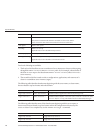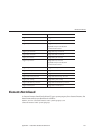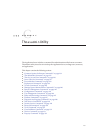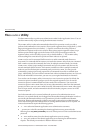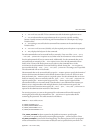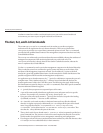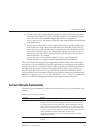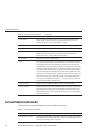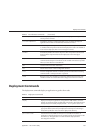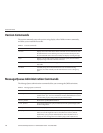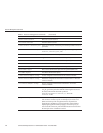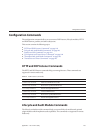
invokemultimode from within a multimodesession; once you exit the second multimode
environment, you return to your original multimode environment.
The Get, Set, and List Commands
The asadmin get, set and list commands work in tandem to provide a navigation
mechanism for the Application Server's abstract hierarchy. There are two hierarchies:
configuration and monitoring and these commands operate on both. The list command
provides the fully qualied dotted names of the management components that have read-only
or modiable attributes.
The configurationhierarchy provides attributes that are modiable; whereas the attributes of
management components from monitoring hierarchy are purely read-only. The
configuration hierarchy is loosely based on the domain's schema document; whereas the
monitoringhierarchy is a little dierent.
Use the list command to reach a particular management component in the desired hierarchy.
Then, invoke the getand set commands to get the names and values or set the values of the
attributes of the management component at hand. Use the wildcard (*) option to fetch all
matches in a given fully qualied dotted name. See the examples for further clarication of the
possible navigation of the hierarchies and management components.
An application server dotted name uses the “.” (period) as a delimiter to separate the parts of a
complete name. This is similar to how the “/” character is used to delimit the levels in the
absolute path name of a le in the UNIX le system. The following rules apply while forming
the dotted names accepted by the get, set, and list commands. Note that a specic command
has some additional semantics applied.
■
A . (period) always separates two sequential parts of the name.
■
A part of the name usually identies an application server subsystem and/or its specic
instance. For example: web-container, log-service, thread-pool-1, etc.
■
If any part of the name itself contains a . (period), then it must be escaped with a leading
\(backslash) so that the “.” does not act like a delimiter.
■
An * (asterisk) can be used anywhere in the dotted name and it acts like the wildcard
character in regular expressions. Additionally, an * can collapse all the parts of the dotted
name. Long dotted name like "<classname>this.is.really.long.hierarchy
</classname>" can be abbreviated to "<classname>th*.hierarchy</classname>."But
note that the . always delimits the parts of the name.
■
The top level switch for any dotted name is --monitor or -m that is separately specied on a
given command line. The presence or lack of this switch implies the selection of one of the
two hierarchies for application server management: monitoring and conguration.
■
If you happen to know the exact complete dotted name without any wildcard character, then
list and get/set have a little dierence in their semantics:
TheGet,Set, andListCommands
SunGlassFishEnterpriseServer2.1AdministrationGuide • December2008236



